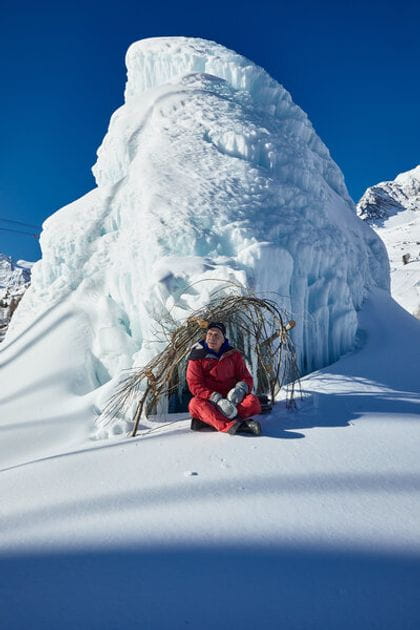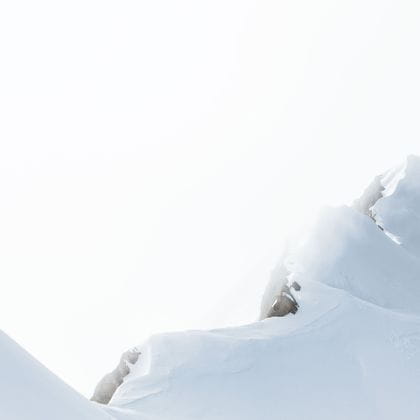We will pull it off
Felix Keller, the wellknown Engadine glaciologist, wants to cover glaciers with artificial snow to slow down their melting. The project‘s goal is to help the many millions of people who face severe water scarcity. He sees climate change as a challenge and not as a doomsday scenario.
Glaciers have been part of the Alps since time immemorial. Most people cannot imagine our mountains bereft of their mighty icy sheathing. Felix Keller can, though: As a glaciologist, he has been researching the evolution of our Alpine glaciers for decades. «It is very likely that they will disappear from our mountains. In Greenland or the Antarctic, though, they will still be around for a while.»

Keller is not a climate change denier –
but neither does he lament over it. To him, taking a scientific view, climate change is the motive to look for possibilities to attenuate it. And Keller believes in the ability of humankind to do things for the climate that would have been unthinkable just a few years ago. «Today, we have more tools than ever to help us fight global warming,» he says, and adds, «Without doubt, the list of options is longer than the list of doomsday scenarios!» Scaring people is pointless, says the glaciologist, who is also well-versed in environmental psychology. «An inner drive will always be stronger than a shove from outside.»
Instead of painting an apocalyptic vision of climate collapse, he wants to do more to show the possibilities of preventing it. «Physical therapists will tell their patients not to think back to the accident, but to think of the many possibilities that still lie ahead.» That‘s how Keller wants to encourage people to act on climate change. He is convinced we will succeed in weaning off fossil fuels. «Glaciers are huge water reservoirs. If they were to disappear, we would not only see the sea level rise sharply but also face severe water shortages in the Alps and other mountainous regions worldwide. To illustrate: more than 200 million people in the Himalayas get their drinking and irrigation water from glaciers.»

The melting of these white giants poses an acute threat to them,
which is why Keller is researching ways to slow down the melting of the glaciers. When – like last winter – we don‘t get much snow, glaciers don‘t form new ice on the surface. Without the snow, less sunlight gets reflected, and the glaciers are less well protected against the heat of the following summer, both of which are crucial. Glaciers shrink, and a lot of water flows off.
Felix plans to trial snow-making on the Morteratsch Glacier near Pontresina to slow down the glacier‘s melting. «We would have to make it snow for fifteen winters before seeing the effect on the glacier snout. Who knows whether I‘ll live to see that,» the sexagenarian says with a grin. He wants to use meltwater from the lake underneath the Pers Glacier higher up to produce man-made snow. His concept envisions water directed into spray nozzles suspended from cables strung across the glacier, sprinkling the water in tiny droplets falling on the glacier as snowflakes. The best part: the drop between the natural lake and the installation would make it work without electricity. Still, environmentalists have expressed their concerns. Felix Keller is understanding: «The Morteratsch Glacier lies in a sensitive area of land. We shouldn‘t burden it with the cable fixtures if the pilot doesn‘t provide new insights; even less so if we have the option to build it somewhere else where it would have an extra benefit for the ocal population.»

The Morteratsch Glacier is one of the most visited glaciers in the area. A favourite hike in summer and a cross-country skiing trail in winter, it is also the final point of the popular glacier ski run from Diavolezza. Still, the project is not a publicity stunt to attract more tourists. «The glacier stores water for 30 to 50 years. Suppose we succeed in making the glacier grow through artificial snow. We could help alleviate major problems for hundreds of millions of people in India, Latin America and other continents.»
Keller is cautiously optimistic: «We were able to solve several technical issues and managed to produce some snow. Now, we are looking for locations that provide large surfaces on which we can install and test our ‹snow cables› for some time.» Work on the full-scale installation on the Morteratsch Glacier could begin as early as 2031.

Dr. sc. nat. ETH Felix Keller (60), glaciologist
Born and raised in Samedan, Felix Keller read glaciology, the study of the internal dynamics and effects of glaciers, at ETH Zurich. He founded the centre for applied glaciology at the Academia Engiadina in Samedan, which he still heads. In 2017, he was elected president of the GlaciersAlive foundation, whose purpose is to understand high-altitude glacier-related water management. The MortAlive project was set up to investigate ways to regenerate glaciers using man-made snow.
www.mortalive.ch
